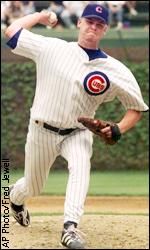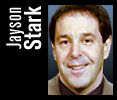His numbers (1-2, 7.36) look more like Sean Bergman's pitching line than
Randy Johnson's. He just went 11 days between starts (official reason:
"tweaked" hamstring). And since his six-inning three-hitter in his return to
the big leagues, he has been ambushed for 19 runs and 32 baserunners in 16
innings.
Oh, Kerry Wood's fastball still crackles up there at 95 miles an hour.
But many miles away from Chicago, a man who has walked in Wood's cleats says
he knows the truth no one seems to want to admit:
|  | | Kerry Wood has given up 17 earned runs in 16 innings of work over his last three starts. |
Kerry Wood isn't ready yet, says Jose Rijo.
And if there's anyone on the planet who ought to understand what it takes to
make it back from Tommy John surgery, it's Rijo -- because he has had it. Five
times.
"It takes two years to make it back," says Rijo, a one-time World Series
MVP who's now in the fifth year of his own comeback from this same operation.
"It takes 12 to 14 months before you feel good in your arm. It takes another
eight to 10 months for your mind to get ready. So you've got two healing
processes to go through -- one for your arm, one for your mind."
Once, it was Jose Rijo who hadn't learned that lesson. Once, it was Jose
Rijo who tried to rush back from this surgery too fast. Now it's Jose Rijo
who wishes he could do it all over. So if Rijo could offer two simple words
of advice for Kerry Wood, he would say this:
Slow down.
"I talked to him a couple times last year in Cincinnati," Rijo says. "The
first thing I told him was: 'You better not rush back.' Me and him, we're the
same kind of pitcher. We both throw the hard fastball and the hard breaking
ball. And it's not as easy for pitchers like us to come back and throw that
hard again."
Once upon a time, you might remember, Jose Rijo was Kerry Wood -- just
about. He arrived in the big leagues in 1984, as an 18-year-old phenom with
the Yankees. At 20, he had a 16-strikeout game for the A's. At 25, he was the
MVP of the 1990 World Series for the Reds.
But at 30, he was trying to figure out why that pain in his elbow wouldn't go
away. Now, after living through the ultimate worst-case scenario following
the surgery that has produced medical miracles for so many others, he doesn't
want anyone else to make the mistakes he made -- especially not a guy as
special as Kerry Wood.
"I would suggest to him to go back and rehab more in the minor leagues,"
Rijo says. "I don't think he's ready to pitch in the major leagues yet. Too
many ups and downs. And if he doesn't deal with that, he could get
frustrated. And then he's in real trouble."
It is only 13 months and three weeks since Wood had a ligament from his
forearm transplanted in his elbow by Dr. James Andrews. That sounds like a
long time ago -- and for many surgical procedures, it would be. But this one
is different.
With this surgery, the men who have it typically think they're further
along than they really are because their new ligament feels so good at first.
But they all find out eventually that their own body has misled them.
"The thing is, you've got to teach that ligament a new job," Rijo says,
"because it comes from a different part of your arm, and before this, it
wasn't doing nothing. Now it's got to be taught to throw every five days, and
to throw in rehab every other day. You say, 'What's going on? Why is this so
hard?' But it's hard because the ligament's got to get used to its new job."
And Jose Rijo speaks with the wisdom of a man who learned that piece of
medical history in about the hardest way imaginable. You think Kerry Wood
came back too soon? Rijo practically tried to go straight from his hospital
bed to the mound.
|
“ |
I want to tell Kerry Wood: When you feel good, don't push it. Don't
say, 'I'm throwing 90. I want to throw 92-93.' No-no. That's when you throw
89. You wait till your arm adjusts to that and you get stronger. Then you go
for 91-92-93. ” |
|
|
— Jose Rijo |
"I came back way too soon," he says. "I came back in six months. I felt
good, and I was rushing to get back and pitch in a game. I pitched in pain
because I wanted to pitch again so bad. But I wasn't ready.
"I thought I felt great. Matter of fact, I pitched in spring training -- and I
pitched great. But I wasn't ready. I didn't have nothing. But I had an
advantage on Kerry Wood. I'd been playing 14 years. So I threw some junk and
fooled them. I knew how to read their feet and keep them off balance. But he
doesn't know that yet. So unless he's ready, unless he's 110 percent, he
won't be able to fool anybody."
But Rijo understands that when you're in the middle of this comeback, you
don't know that yet. You think you're fine -- but you keep slamming into a
wall you can't see.
"That's the one thing I really found out," he says. "It's not a matter of
how good you feel. The better you feel, the slower you should go, because you
want to feel that good for a long time. In my case, the better I'd feel, the
more I'd throw and the harder I'd throw. And that's when you get in trouble.
"So I want to tell Kerry Wood: When you feel good, don't push it. Don't
say, 'I'm throwing 90. I want to throw 92-93.' No-no. That's when you throw
89. You wait till your arm adjusts to that and you get stronger. Then you go
for 91-92-93."
Here's how that strategy turned out for Jose Rijo: He had his original
Tommy John surgery in August, 1995. He needed another operation the next
April. He needed a third the following November. Then came a fourth the next
August. He was back in spring training the next year -- and needed yet one
more operation before the year was done.
So then, at age 33, Jose Rijo turned his love of baseball in a different
direction. He built a 300-acre baseball academy in the Dominican Republic --
Loma del Sueno -- complete with eight fields, two gyms, four locker rooms and
living facilities for 600 kids. He sponsors the Jose Rijo Little League for
1,200 kids. He scouts for the Reds in the Dominican. So he has done
everything imaginable to prepare himself for a life beyond the pitcher's
mound.
"But I miss the game," he says, "big-time. So I'm still trying to make it
back. I'm trying right now. I was throwing forkballs and sliders just today."
He plans to start pitching again in the Dominican Summer League in July.
But he also knows now that even if he makes it back, he will never be the
same pitcher he was. So he roots for Kerry Wood. And John Smoltz. And Kerry Ligtenberg. And the other pitchers who have been through this surgery. But
this time, Jose Rijo isn't just dispensing his own advice. He's taking it.
"This time," he says, "I'm taking it slow. I should have done that the
first time."
Jayson Stark is a senior writer at ESPN.com. | |
ALSO SEE
Jayson Stark archive
Wood, Cubs bullpen blow 6-0 lead at Coors

|



